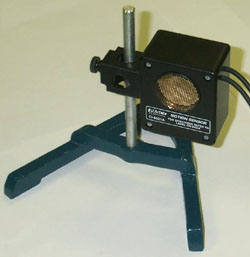 We
have previously remarked that there
are two very basic classes of waves, longitudinal and transverse
waves. So far we have really only studied waves
on strings, which are great examples of transverse waves. This present chapter deals with sound, which is the prime example of longitudinal pressure
waves.
We
have previously remarked that there
are two very basic classes of waves, longitudinal and transverse
waves. So far we have really only studied waves
on strings, which are great examples of transverse waves. This present chapter deals with sound, which is the prime example of longitudinal pressure
waves.
Waves in a string really look like sine waves. The motion is transverse, and although no material is actually displaced in the direction of propagation, energy can be transmitted. It is much harder to visualize a longitudinal wave like Sound.
In this figure on the right, we show the pressure waves of a sound wave in air (shades of light blue) inside in a pipe (indicated by the red lines).
 Below
the pipe, we plot the air pressure as a function of the horizontal
coordinate. The zero in this plot is suppressed, because zero
pressure lies way off the bottom of the page. Sound represents a
small perturbation of the density (or pressure) of the material. High
density regions move to the right (or left) and constitute the
traveling wave. But remember, in a wave it is the disturbance, i.e.
energy, that moves, not the material itself.
Below
the pipe, we plot the air pressure as a function of the horizontal
coordinate. The zero in this plot is suppressed, because zero
pressure lies way off the bottom of the page. Sound represents a
small perturbation of the density (or pressure) of the material. High
density regions move to the right (or left) and constitute the
traveling wave. But remember, in a wave it is the disturbance, i.e.
energy, that moves, not the material itself.
What can you use sound for - except, of course, to hear it? Sound sensors are used in motion detectors, like the one shown on the left. Ultrasound is routinely used for imaging during pregnancies. And sonar, another form of sound, is used for navigation of submarines. Research on sound perception by the human brain is a very active and interesting field. Clearly, sound is more than meets the ear...
© MultiMedia Physics, 1999/2000